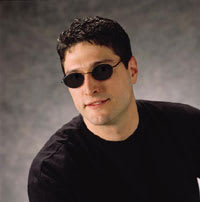|
|
|
SunSensors lenses by Corning: Indoors. |
Shadow Dance
How three chains grow their photochromics business
By Erinn Morgan
CFor some chains, the photochromics category is growing due to new products and an increasing customer base. Others find it a more challenging business. Regardless, most say they are forging ahead with photo-chromics and supporting the category in-store with promotional tactics.
"We push it at the store level," says Aaron Schubach, lab manager and lens buyer at Standard Optical, which has 16 locations in Utah. "With photochromics representing a small chunk of our business-so far-we don't really advertise it outside the stores. We just do the sales and marketing work right in the store."
Smart Strategies
Some chains, however, do a huge business in photochromics. Take Bard Optical, for example, with 19 locations in Central Illinois. "We do very well with Transitions, especially when we changed from Transitions Plus to Transitions 3," says general manager Shirley Wanamaker. "In fact, we are way above the national average at about 40 percent of our total lens sales going to
photochromics."
Wanamaker attributes being located in the Midwest as a part of this success. "It makes it easy for us because our customers are typically more mature," she explains.
But Bard also employs an interesting strategy when making the lens and frame sale, which also helps increase its photochromics business. "A lot of our frames come with clips," says Wanamaker. "We either sell the clip as part of a package or we just include it in the sale. Either way, the customer almost always wants it."
And along with the frame-and-clip sale, Bard promotes placing variable tint lenses in the glasses.
"We will put a variable tint in as their prescription lens and then they have the clip for real protection," she says. "So when they are going in and out of work they are fine with the photochromic lens, but when they will be driving all day long or just outdoors, we push the clip for them to have the full UV protection."
|
HOT PRODUCTS
Some say new and innovative products are also boosting photochromics sales figures.
For example, many chains mentioned that they will be rolling out the new Transitions "Splitz" lenses, which turn from one color to another (yellow to orange, blue to green, or pink to purple). "It will be hot in the college market and the younger trendy sunglass markets," predicts Wanamaker. Bard will sell the lenses for $149 a pair.
"It's more of a fashion trend," says Joe Plaza, lab manager of Eye Centers of Florida, which has 25 locations in southwestern Florida. "But just as you see hot pants making a comeback, you will also see people walking down the street with their lenses that change color."
"We are doing a lot with Corning/Signet-Armorlite," says Schubach. "They (SunSensors) come only in high-index, and this helps us upgrade the price and boost our margins." For example, Standard sells single-vision SunSensors photochromics for $239.95 (in high index with scratch-resistant and UV coatings), and progressives at $379.95. "That's the best lens you can get," he says. "It's a premium lens, and we are selling a fair amount."
In-Store Positioning
The fact that LensCrafters promotes second-pair sunglass sales over photochromics is viewed by some chains as a positive, because it gives their own stores something different.
To underscore the availability of photochromics, chains are employing a variety of in-store marketing tactics. They cite effective use of point-of-purchase materials, querying customers on their lifestyle habits, motivating the sales staff, and occasional advertising as the strategies that work best.
|
|
|
|
SunSensors lenses by Corning: Outdoors. |
"We use all the P-O-P that Transitions has put out," says Wanamaker. "We particularly like what we call the 'little Barbie tanning bed,' which is a light box where we place the lenses and the customers can see in 45 seconds how it changes. They can quickly see the difference between before and after."
Adds Schubach, "The best way to show it is to have a sample lens in the store." He says that as a result of in-store promotions, they now represent about 10 percent of total lens sales. He says demonstrating them is easy: "You just run outside and show the patient how it works."
At Eye Centers of Florida, the opticians try to get a customer profile from each patient and then try to fit their needs with the appropriate products, including photochromics.
"We have a profile sheet they work with to determine if they will benefit from photo-chromics," says Plaza. "For example, we point out to patients that photochromics can help improve their performance vision, especially with the brown tones."
Still, most chains find that one of the most effective ways to sell more photochromics is to motivate the staff.
"The big thing that sells it is that we spiff it," explains Wanamaker. "Then the individual dispensers have the incentive to sell it to customers."
Surely, the experiences of these larger optical retailers illustrates that combining some savvy business strategies with an eye to new products and opportunities provides new avenues for more business in the ever-changing and growing photochromic lens business. EB
Erinn Morgan is the fashion and market editor of Eyecare Business. For commentary on this article and thoughts on other issues affecting chains, contact her at Eyecare Business, 535 Connecticut Avenue, Suite 104-A, Norwalk, CT 06854-1722 or e-mail erinnmo@aol.com.





